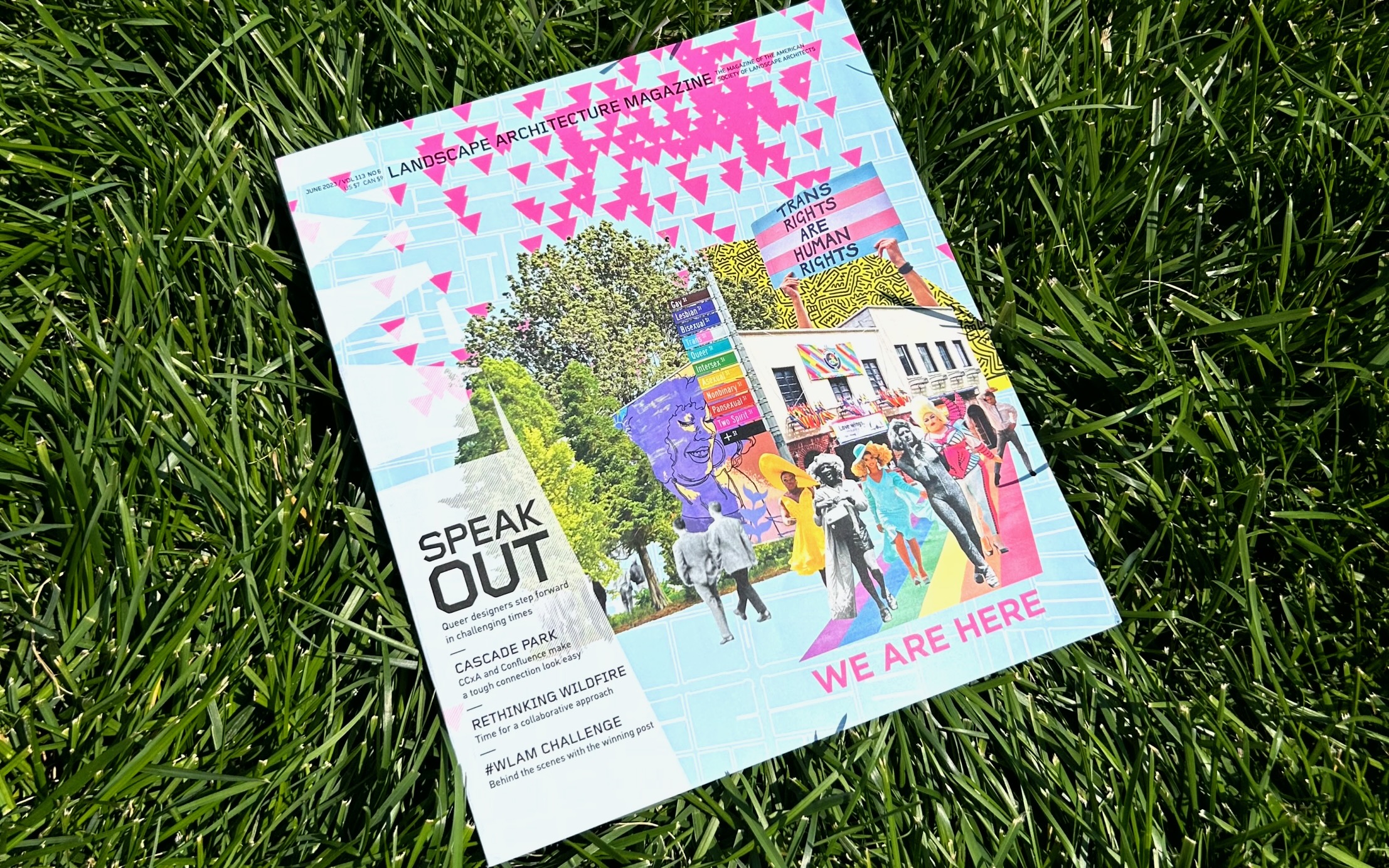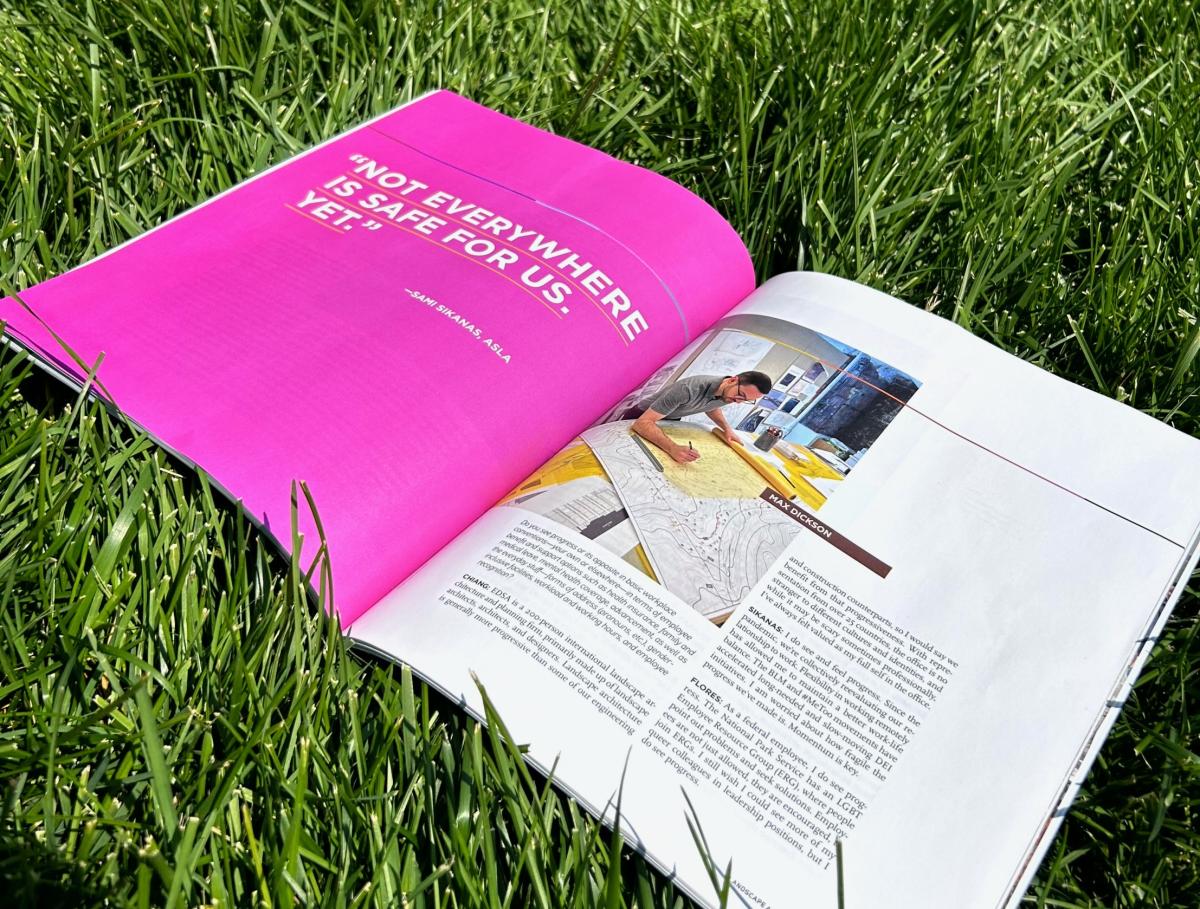Max Dickson (he/him) earned a Master of Landscape Architecture and a Master of Urban and Regional Planning from the University of Minnesota in 2019. After graduation, Dickson moved to Philadelphia to work with OLIN, an internationally awarded landscape architecture and urban design firm. At OLIN, Dickson’s work has focused on district-scale urban spaces, and leading the emergent research initiative through OLIN Labs called PrideScapes, an exploration of LGBTQ+ landscapes and people within the field of landscape architecture.

Until 2020, the American Society of Landscape Architects (ASLA) had never focused on PRIDE. Dickson’s work through PrideScapes grew his national presence as an LGBTQ+ leader and since then he has spoken at various local and national conferences, most recently the 2023 APA National Planning Conference, 2022 ASLA Conference on Landscape Architecture, and The Cultural Landscape Foundation’s Oberlander Prize Forum II about his work with LGBTQ+ landscapes. The June 2023 issue of Landscape Architecture Magazine highlights PRIDE and features Dickson and his collage on the cover. In this interview, Dickson discusses his work and rapidly expanding presence in landscape architecture.

Tell us more about launching PrideScapes and its impacts.
PrideScapes launched in 2020 through OLIN’s internal research group, OLIN Labs. Labs seeks to grow the impact of the landscape architectural profession through original research, thought leadership, and by building platforms for purpose-driven collaboration and activism.
Like many other firms and professional organizations at the time, OLIN had never celebrated Pride before, so PrideScapes that first year was a week-long series internal to the office. The goal was to celebrate OLIN’s LGBTQ+ employees, educate people on the broad spectrum of issues facing the LGBTQ+ community, and provide resources to the office. I presented on designing for LGBTQ+ inclusion and highlighted some queer spaces in the built environment during one of those days.
Digging deeper into that research and those landscapes was eye-opening and became the focus of the now public-facing initiative. PrideScapes explores queer landscapes and seeks to clarify the importance of preserving queer spaces, telling untold queer histories, and imagining new futures for historically and culturally significant queer landscapes. It is also a platform to build community, form solidarities, and create visibility within the profession.
We hope to create spaces for queer and trans landscape designers, architects, and planners to advocate, share work and support one another. It has been amazing to see this initiative continue to grow and morph into what it is today over the past three years.

Describe your recent conference talks. What were their context and impacts?
They stemmed from the fact that visibility, research, and discussion of queer spaces and people within landscape architecture have largely been missing from the profession’s discourse. As designers, we know that place and identity are closely linked. Having physical echoes of queer identities in the landscape and profession is incredibly important. It can help queer and trans people connect with their own identity, reinforce a sense of belonging, and proudly acknowledge that queer and trans people have always existed in these spaces. As PrideScapes grew, I knew that a key component of this work would be to help tell these stories, underscore the value of preserving these sites, and increase the overall visibility of these spaces and queer professionals across the U.S.
The response to these conference talks and the other PrideScapes efforts has been amazing. It’s been extremely positive and I think people have long wanted to be seen and have this representation in the profession. I know I have! It’s been inspiring to connect with so many queer students and other queer landscape designers and landscape architects and hear from them as we build a larger community and network within the profession.

What are your plans, and also big dreams, for the work you are doing to raise consciousness around LGBTQ+ places and people in landscape architecture?
I am excited to be involved in creating an LGBTQ+ working group at the national level within ASLA. At the 2021 ASLA Conference on Landscape Architecture in Nashville, a small, word-of-mouth gathering of LGBTQ+ landscape architects occurred. Last year in San Francisco, we spread the word further and had around 50 people gather. It was here that the working group was formed to establish a national-level LGBTQ+ community within landscape architecture. As part of this group, we had a panel at LABash, organized June Pride events with ASLA and LAM, and will host a few events at the ASLA conference in Minneapolis this October! The goal is to raise our collective voices, our presence in practice, and awareness of our continued fight for equal human rights. Everyone should follow @PRIDExASLA on Instagram to keep up with what we are doing!
For PrideScapes, I continue to advance research around queer public spaces and amplify these landscapes and their histories by asking, “How can we connect public spaces with visible queer and trans identities and stories?” It’s been great to see more students address questions like this in studio projects and other coursework, so I am excited to see what new ideas, observations, and approaches enter the conversation.
What advice would you give to landscape architecture students and recent graduates?
Keep learning, keep exploring topics that interest you, and stay involved. There are so many organizations and resources available that I wish I knew about as a student. Step out of your comfort zone and reach out to professionals. Take advantage of meeting new people, and go to conferences, lectures, and other presentations. And most importantly, don’t be afraid to bring your full self to your design work, job, or coursework. It will make you shine.
After almost a decade of practice in urban design, Anna Claussen (MLA ’07) broke out of traditional practice to explore how sociopolitical issues relate to surrounding landscapes.
It wasn’t until he became a TA during graduate school that Professor Emeritus John Koepke realized he enjoyed teaching as much as working in a design firm. After hearing about an open position at the University of Minnesota, Koepke gave “the best interview of his life” and became Department of Landscape Architecture Head. During his time, Koepke helped the department become internationally ranked and built long-term connections with communities across Minnesota. In this interview, Koepke discusses his favorite parts about teaching, the challenges he faced, and gives advice to design professionals and academics.
In 1972, Clinton Navarro Hewitt was hired at the University of Minnesota and quickly promoted to Associate VP of Planning. For the next 37 years, Hewitt would shape the U of M’s campuses across the state through dozens of landmark building projects—including Scholar’s Walk, David M. Lilly Plaza, and the Weisman Art Museum—and impact the lives of countless students and colleagues. To celebrate his career of building community and expanding the field of landscape architecture, the Department of Landscape Architecture has worked with the UMN Archives to create the Clinton N. Hewitt archive.





